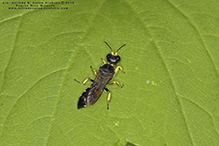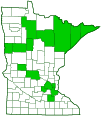square-headed wasp
(Ectemnius maculosus)
Conservation • Description • Habitat • Ecology • Distribution • Taxonomy
Conservation Status |
|
|||||||
| IUCN Red List | not listed |
|||||||
| NatureServe | not listed |
|||||||
| Minnesota | not listed |
|||||||
Description |
||
Ectemnius maculosus is a small square-headed wasp. It occurs in the United States east of the Great Plains and across southern Canada. Adults are ⅜″ (10 mm) in length and black with yellow markings. The head is large, square, and black. There are two large compound eyes on the sides of the head and three small simple eyes (ocelli) in a triangle on top of the head. The shape of the triangle is low, meaning the sides are shorter than the base. There is a longitudinal ridge in front of the ocelli and a transverse ridge behind the compound eyes. The compound eyes do not have a sharp groove (fovea) on the inner margin. On males, the back of the head is distinctly narrowed behind the compound eyes. The upper part of the forehead (frons) is evenly pitted (punctate). The plate on the face (clypeus) has a large, polished, extension (bevel) on the upper margin. It is entirely black on both sexes. The jaws (mandibles) are mostly yellow above, black just near the tip, and are entirely black below. The antennae rise low in the face. They consist of a long basal segment (scape), a short connecting segment (pedicel), and a whip-like end section (flagellum) with several segments (flagellomeres). The scape is yellow, the pedicel and flagellum are brown. The first flagellomere is more than twice as long as wide. The second flagellomere is depressed on the underside near the base. The thorax is black and has three segments, the prothorax, mesothorax, and metathorax. However, the first segment of the abdomen (propodeum) is fused to the thorax, giving the thorax the appearance of having four segments. The upper plate on the prothorax (pronotum) is short and collar-like. It extends rearward on the sides to the plate at the base of each wing (tegula). It appears horseshoe-shaped when viewed from above, triangular when viewed from the side. It is mostly black except for a yellow band on the front margin of the upper surface. The band is interrupted in the middle. On the mesothorax, the large front plate (mesoscutum or scutum) is black with no yellow markings. It has transverse microridging in front and longitudinal microridging in the rear. The smaller rear plate (scutellum) has a pair of narrowly separated, yellow spots. The upper surface of the metathorax (metanotum) is entirely black, with no yellow markings. On the lower front of each side of the thorax there is a small yellow spot. On the rear part of the body the second through fifth segments (tergites) have a pair of narrow, widely separated spots on the front margin. On the fifth tergite the spots are even more widely separated. The wings are tinted brown. On the forewing there is a single submarginal cell. The recurrent vein ends in the outer third of the submarginal cell. On all legs the third segment (femur) is black, the fourth segment (tibia) is yellow, and the last part of the leg (tarsus), corresponding to the foot, is yellow. On the front legs the femur has a sharp, rearward-pointing spur near the middle. It does not have a sharp ridge or tooth on the underside near the base. |
||
Size |
||
⅜″ (10 mm) |
||
Similar Species |
||
Habitat |
||
|
||
Ecology |
||
Season |
||
|
||
Behavior |
||
|
||
Life Cycle |
||
The nest is usually built in pithy stems. It is provisioned with paralyzed adult flies. |
||
Larva Food |
||
Flies |
||
Adult Food |
||
Flower nectar |
||
Distribution |
||||
|
Sources |
|||
| 5/8/2023 | ||||
Occurrence |
||||
|
||||
Taxonomy |
|||
Order |
Hymenoptera (ants, bees, wasps, and sawflies) | ||
Suborder |
Apocrita (narrow-waisted wasps, ants, and bees) | ||
Infraorder |
Aculeata (ants, bees, and stinging wasps) | ||
Superfamily |
Apoidea (bees and apoid wasps) | ||
Family |
Crabronidae (square-headed wasps, sand wasps, and allies) | ||
Subfamily |
Crabroninae | ||
Tribe |
Crabronini (square-headed wasps) | ||
| Subtribe | Crabronina | ||
Genus |
Ectemnius | ||
Synonyms |
|||
Crabro frigidus Crabro oblongus Crabro quadrangularis Crabro quatuordecimmaculatus Crabro singularis Crabro trapezoideus Ectemnius oblongus Ectemnius singularis Ectemnius trapezoideus Solenius singularis Solenius trapezoideus Vespa maculosa |
|||
Common Names |
|||
This species has no common name. The name of the tribe Crabronini is square-headed wasps, and it is adopted here for convenience. |
|||
Glossary
Clypeus
On insects, a hardened plate on the face above the upper lip (labrum).
Femur
On insects and arachnids, the third, largest, most robust segment of the leg, coming immediately before the tibia. On humans, the thigh bone.
Flagellomere
A segment of the whip-like third section of an insect antenna (flagellum).
Frons
The upper front part of an insect’s face, roughly corresponding to the forehead.
Ocellus
Simple eye; an eye with a single lens. Plural: ocelli.
Pronotum
The exoskeletal plate on the upper side of the first segment of the thorax of an insect.
Scutum
The forward (anterior) portion of the middle segment of the thorax (mesonotum) in insects and some arachnids.
Tarsus
On insects, the last two to five subdivisions of the leg, attached to the tibia; the foot. On spiders, the last segment of the leg. Plural: tarsi.
Tegula
A small, hardened, plate, scale, or flap-like structure that overlaps the base of the forewing of insects in the orders Lepidoptera, Hymenoptera, Diptera, and Homoptera. Plural: tegulae.
Tergite
The upper (dorsal), hardened plate on a segment of the thorax or abdomen of an arthropod or myriapod.
Tibia
The fourth segment of an insect leg, after the femur and before the tarsus (foot). The fifth segment of a spider leg or palp. Plural: tibiae.
Visitor Photos |
|||||
Share your photo of this insect. |
|||||
| This button not working for you? Simply email us at info@MinnesotaSeasons.com. Attach one or more photos and, if you like, a caption. |
|||||
Alfredo Colon |
|||||
 |
|||||
MinnesotaSeasons.com Photos |
|||||
|
|||||

Slideshows |
||

Visitor Videos |
|||
Share your video of this insect. |
|||
| This button not working for you? Simply email us at info@MinnesotaSeasons.com. Attach a video, a YouTube link, or a cloud storage link. |
|||
Other Videos |
|||

Created: 5/8/2023
Last Updated:


